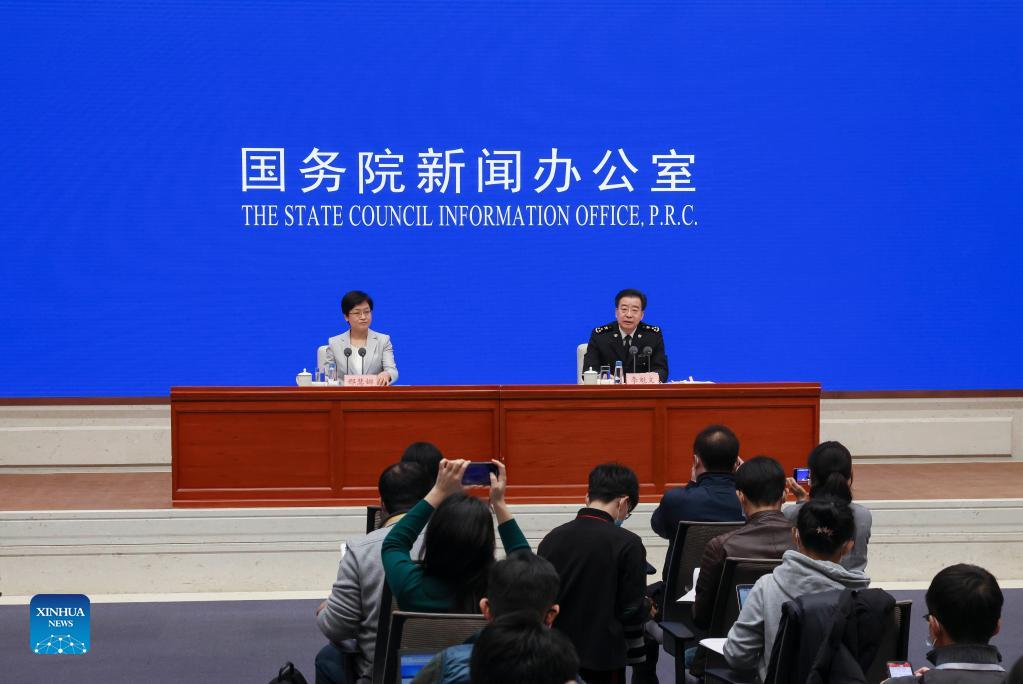China's foreign trade hits new high in 2021

Li Kuiwen (back R), spokesperson of the General Administration of Customs (GAC), attends a press conference held by the State Council Information Office in Beijing, capital of China, Jan. 14, 2022. (Xinhua/Yin Gang)
BEIJING, Jan. 14 (Xinhua) -- China's foreign trade moved up another notch in 2021, exceeding 6 trillion U.S. dollars for the first time, despite the COVID-19 pandemic continuing to weigh on global trade, official data showed Friday.
The total trade in goods amounted to 6.05 trillion U.S. dollars, up 1.4 trillion U.S. dollars from a year ago, according to the General Administration of Customs (GAC).
The trade volume in yuan terms expanded 21.4 percent year on year to 39.1 trillion yuan, with exports up 21.2 percent to 21.73 trillion yuan and imports up 21.5 percent to 17.37 trillion yuan.
"China has been at the forefront of economic development and pandemic response globally, and maintained rapid growth in foreign trade, which registered a record high in volume and steady progress in quality," GAC spokesperson Li Kuiwen said.
The country's imports and exports with its top three trading partners -- ASEAN, the European Union and the United States -- gained 19.7 percent, 19.1 percent and 20.2 percent, respectively, while its trade with Japan and the Republic of Korea climbed 9.4 percent and 18.4 percent.
The trade volume with economies involved in the Belt and Road Initiative reported a higher-than-average increase of 23.6 percent.
China's hard-won trade growth came as a resurgence in COVID-19 infections, dominated by the Delta and Omicron variants, dealt a major blow to the global supply chain and seriously disrupted the flow of goods.
While many parts of the world grappled with closed factories and congestion at ports and railway stations, China, the first to recover from the pandemic shock, transported badly-needed products, from daily necessities to electronics and medicines, swiftly and safely to marketplaces across the globe.
China's exports of medical materials and medicines more than doubled last year, and products related to the stay-at-home economy, such as laptops and home appliances, witnessed a 13.2-percent increase following an already-strong growth in 2020.
The hundreds of millions of face masks, protective suits, test kits and vaccine doses provided by China to the global community since the COVID-19 outbreak have helped fight the pandemic and facilitated the global economic recovery, Li said.
Meanwhile, the country's robust imports also gave a boost to economies around the world that were still reeling from the pandemic.
In 2021, China's purchases of intermediate and consumer products overseas gained 24.9 percent and 9.9 percent, respectively, from a year ago in 2021, the GAC data shows. The country's imports accounted for 12.1 percent of the world's total in the first three quarters of 2021, up 0.5 percentage points from a year ago.
"China's wider opening-up allowed the world to enjoy more dividends of its economic growth and prosperous consumption," Li said. The country became the world's second-largest importer in 2009.
Friday's data also added to the evidence of a resilient Chinese economy and reassured global investors and observers that the country remains a powerful engine of global growth and development.
Buoyant exports have become a pillar of China's economy, said Zhang Zhiwei, chief economist of Pinpoint Asset Management.
China's foreign trade reached the 4-trillion-USD mark in 2013 and surpassed 5 trillion and 6 trillion U.S. dollars at one go in 2021. The trade increment last year equals the total volume in 2005.
Thanks to the dynamic trade, the Chinese economy was expected to have ended 2021 on a strong note and will get off to a good start this year. In its latest predictions, the World Bank put China's real GDP growth for 2021 at an estimated 8 percent, moderating mildly in 2022 to a still-solid 5.1 percent.
"The country's exports will remain strong in the first quarter of this year as global demand remains robust and the pandemic worsens in many developing countries," Zhang said.
The National Bureau of Statistics will on Monday release a series of economic indicators for 2021, including the country's GDP, industrial output, fixed-asset investment and retail sales.
Despite a satisfactory 2021, Li pointed out that China's foreign trade will face rising uncertainty and instability this year as the pandemic remains serious around the globe and the recovery in global demand is slowing down.
"Given these difficulties and challenges, we should recognize that China's economy is resilient and its sound long-term fundamentals will remain unchanged," Li said, voicing undented confidence in stabilizing foreign trade.
The Chinese government unveiled new guidelines on Tuesday to ease pressures on foreign-trade companies and keep exports and imports stable.
The guidelines detail measures including fiscal and financial support for foreign-trade companies, incentives for new forms of businesses, and efforts to ease the supply-chain risks and further enhance trade liberalization and facilitation.
Also good news for China's efforts to maintain trade growth, the Regional Comprehensive Economic Partnership (RCEP) agreement, signed by 15 Asia-Pacific countries including China, entered into force on Jan. 1, creating the world's largest trade bloc.
China's imports and exports with the other 14 RCEP members combined went up 18.1 percent year on year to 12.07 trillion yuan in 2021, accounting for 30.9 percent of the country's total foreign trade.
Photos
Related Stories
Copyright © 2022 People's Daily Online. All Rights Reserved.










